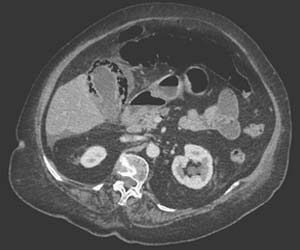- Home
- Editorial
- News
- Practice Guidelines
- Anesthesiology Guidelines
- Cancer Guidelines
- Cardiac Sciences Guidelines
- Critical Care Guidelines
- Dentistry Guidelines
- Dermatology Guidelines
- Diabetes and Endo Guidelines
- Diagnostics Guidelines
- ENT Guidelines
- Featured Practice Guidelines
- Gastroenterology Guidelines
- Geriatrics Guidelines
- Medicine Guidelines
- Nephrology Guidelines
- Neurosciences Guidelines
- Obs and Gynae Guidelines
- Ophthalmology Guidelines
- Orthopaedics Guidelines
- Paediatrics Guidelines
- Psychiatry Guidelines
- Pulmonology Guidelines
- Radiology Guidelines
- Surgery Guidelines
- Urology Guidelines
Rare case of emphysematous Cholecystitis- A report

Dr Sondes Mhamdi and Dr Kais Mhamdi at Centre Hospitalier de Dreux, Dreux, France have reported a rare case of emphysematous Cholecystitis. The case has appeared in the New England Journal of Medicine.
Emphysematous cholecystitis, known less commonly as clostridial cholecystitis, is an acute infection of the gallbladder wall caused by gas-forming organisms (eg, Clostridium or Escherichia coli). Elderly males, especially diabetics, are particularly susceptible to clostridial cholecystitis (emphysematous cholecystitis). This condition develops in approximately 1% of all cases of acute cholecystitis and is generally considered a surgical emergency. An infrequent, insidious, and rapidly progressive form of acute cholecystitis, emphysematous cholecystitis is characterized by early gangrene, perforation of the gallbladder and high mortality. Emphysematous cholecystitis is associated with much higher rates of gangrene and perforation of the gallbladder and significantly increased rates of mortality (15-25%).
An 80-year-old man with a history of hypertension presented to the emergency department with a 2-day history of abdominal pain in the right upper quadrant. The patient was febrile. On physical examination, he had abdominal tenderness in the right upper quadrant, and Murphy’s sign was positive. Laboratory studies revealed a white cell count of 20,000 per cubic millimeter (reference range, 4000 to 10,000).
The alanine aminotransferase, aspartate aminotransferase, bilirubin, and lipase levels were normal. Findings on computed tomography of the abdomen included the presence of air encircling an inflamed gallbladder, with air tracking along the wall of the superior mesenteric vein, and a diagnosis of emphysematous cholecystitis was made. Intravenous broad-spectrum antibiotic agents were initiated, and a laparoscopic cholecystectomy was performed.
A gangrenous and perforated gallbladder, including two gallstones, was resected. Bile cultures grew Escherichia coli and Klebsiella pneumoniae. The patient recovered after the surgery and was treated with a 10-day course of antibiotics. At a follow-up visit 4 weeks after discharge from the hospital, he was doing well and reported no abdominal pain.
For more details click on the link: DOI: 10.1056/NEJMicm1814551

Disclaimer: This site is primarily intended for healthcare professionals. Any content/information on this website does not replace the advice of medical and/or health professionals and should not be construed as medical/diagnostic advice/endorsement or prescription. Use of this site is subject to our terms of use, privacy policy, advertisement policy. © 2020 Minerva Medical Treatment Pvt Ltd